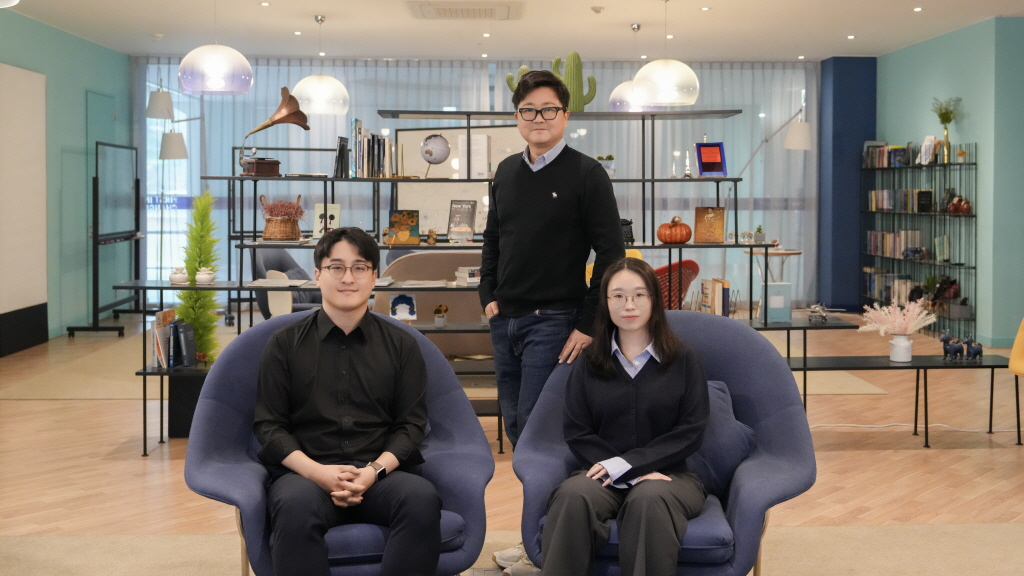UNIST(총장 박종래) 화학과 권오훈 교수팀이 투과전자현미경 안에서 미세시료의 온도를 정밀하게 측정할 수 있는 범용 ‘나노온도계’를 개발했다.

▲(왼쪽부터)박원우 연구원(제1저자), 권오훈 교수, 최예진 연구원
UNIST, 투과전자현미경 내 미세시료 온도 측정 기술 개발
실시간으로 물질의 초미세구조와 온도 변화를 동시에 관측할 수 있는 기술이 개발돼 시료의 특이구조와 열역학적 특성 간의 상관관계를 분석해 첨단 소재 개발에 쓰일 수 있을 전망이다.
UNIST(총장 박종래)는 화학과 권오훈 교수팀이 투과전자현미경 안에서 미세시료의 온도를 정밀하게 측정할 수 있는 범용 ‘나노온도계’를 개발했다고 2일 밝혔다.
개발된 나노온도계는 온도계 역할을 하는 나노입자가 전자빔을 맞아 방출하는 음극선 발광 스펙트럼을 분석해 온도를 측정하는 방식이다.
투과전자현미경은 시료의 미세구조를 관찰하기 위한 빛으로써 전자빔을 이용하는데, 이 전자빔을 온도 측정에도 활용하는 것이다.
기존에 개발된 나노온도계는 실시간(in situ) 투과전자현미경을 이용한 미세구조 변화 관측과 함께 활용할 수 있지만 전자빔의 세기에 따라 매번 보정을 한 후 사용해야 하는 번거로움이 있었다.
이번 연구에서 연구팀은 나노온도계 소재를 바꿔 온도계의 신뢰도와 범용성을 향상시켰다. 음극선 방출 소재로써 디스프로슘 이온(Dy3+)을 택한 것이다.
제1저자인 박원우 연구원은 “디스프로슘 이온의 음극선 발광 스펙트럼에서 나타나는 양자 상태의 분포가 전자빔의 세기와 무관하게 온도에만 의존하는 볼츠만 분포를 따르기 때문”이라고 설명했다.
볼츠만 분포는 온도가 높아질수록 고에너지 양자 상태의 비율이 증가하는 현상을 설명하는 통계 분포이다.
연구팀은 디스프로슘 이온을 전자빔의 고에너지를 견딜 수 있는 이트륨 바나데이트(YVO4)에 도핑해 150㎚ 크기의 나노온도계 입자를 합성했다.
개발된 온도계로 주변 온도를 -170℃∼50℃로 바꿔가며 측정했을 때 약 4℃ 이내의 측정 오차를 보였다.
또한 시료에 레이저빔을 조사해 온도를 올리고 온도 변화의 공간 분포를 추적하는 데도 성공했다.
이는 외부 자극에 의해 실시간으로 변화하는 온도와 구조를 동시에 관측할 수 있는 기술의 유효성을 입증하는 결과이다.
권오훈 교수는 “나노온도계의 소재를 새롭게 설계해 온도 측정의 신뢰도를 크게 향상시켰고 범용성도 확보했다”라며 “충·방전에 따라 온도에 민감한 이차전지 소재 및 디스플레이 소재 개발에도 기여할 것”이라고 말했다.
이번 연구는 파벨 올신(Pavel K. Olshin) 박사가 공동 제1저자로, 유니스트 졸업생으로서 지난해 서울대학교 화학부에 부임한 김예진 교수가 공동 저자로 참여했다.
연구결과는 나노기술 분야의 권위 학술지인 에이씨에스나노(ACS Nano)에 지난달 10일에 출판됐다. 연구 수행은 삼성미래기술육성사업과 한국연구재단의 지원을 받아 이뤄졌다.
